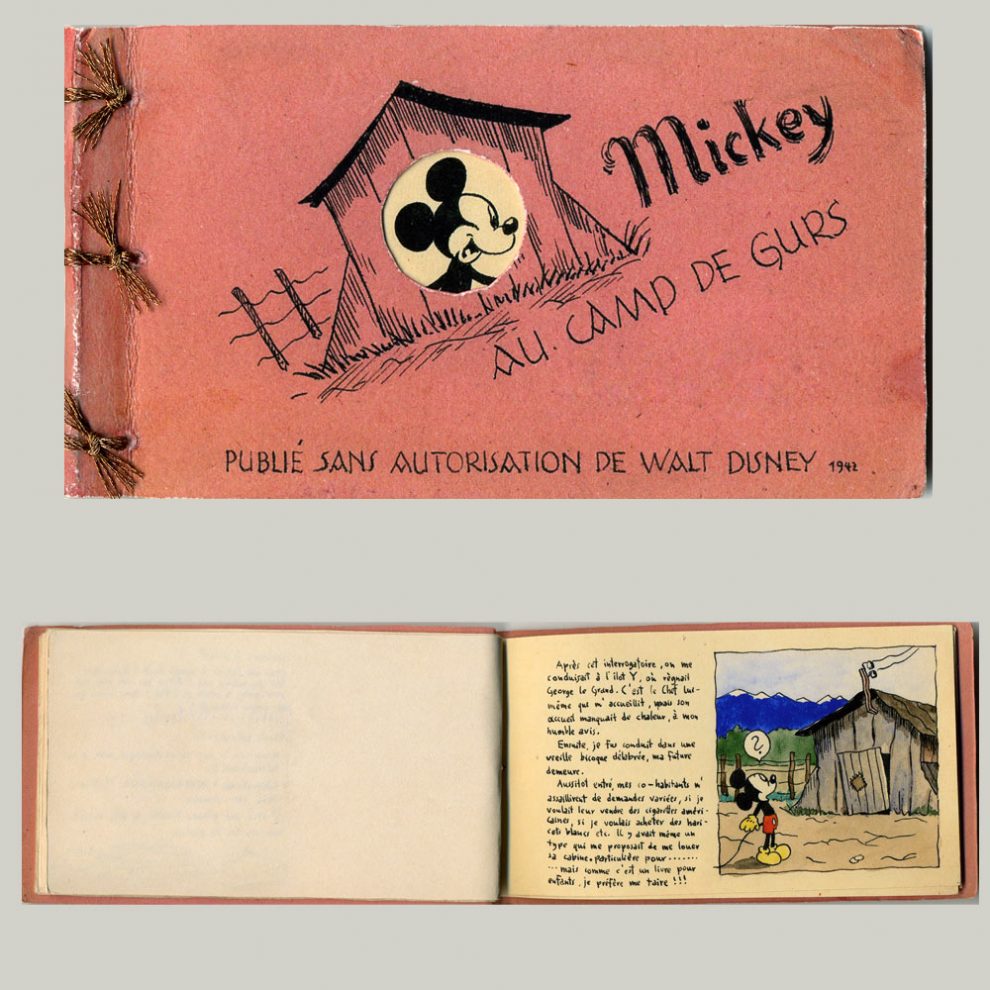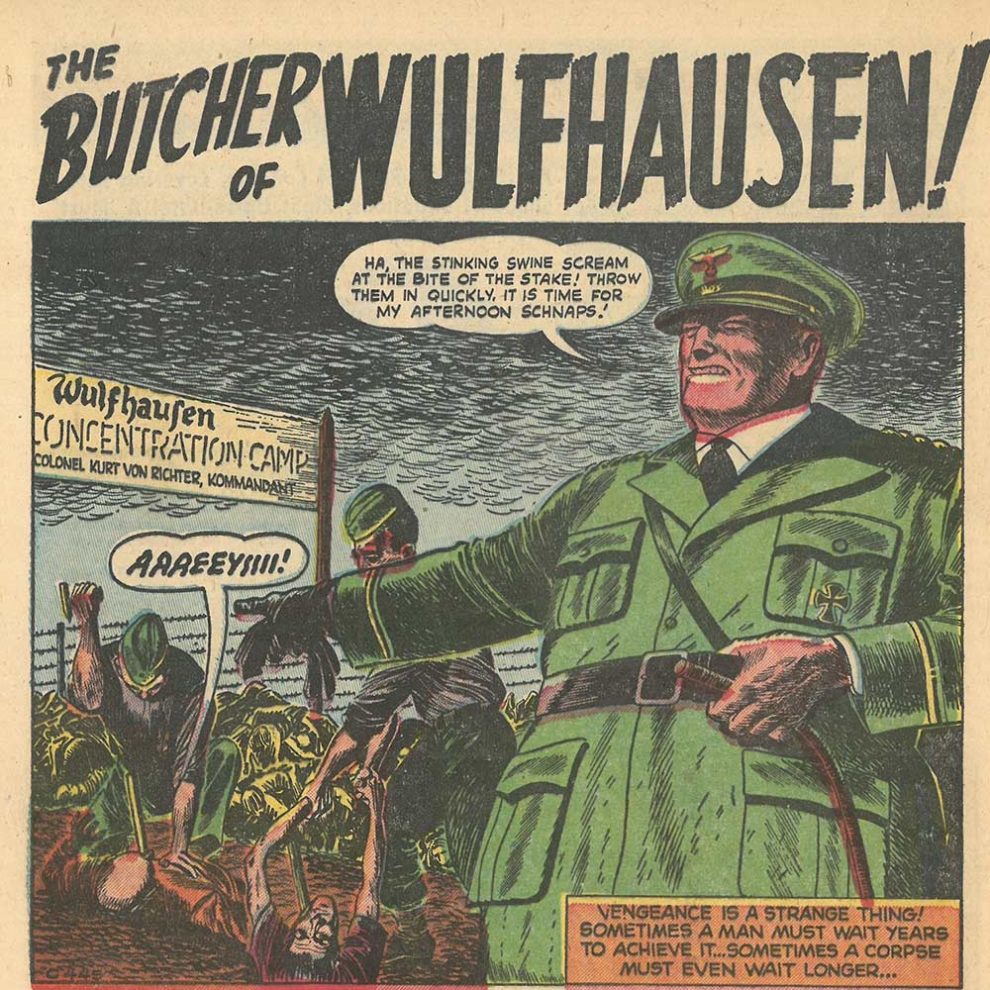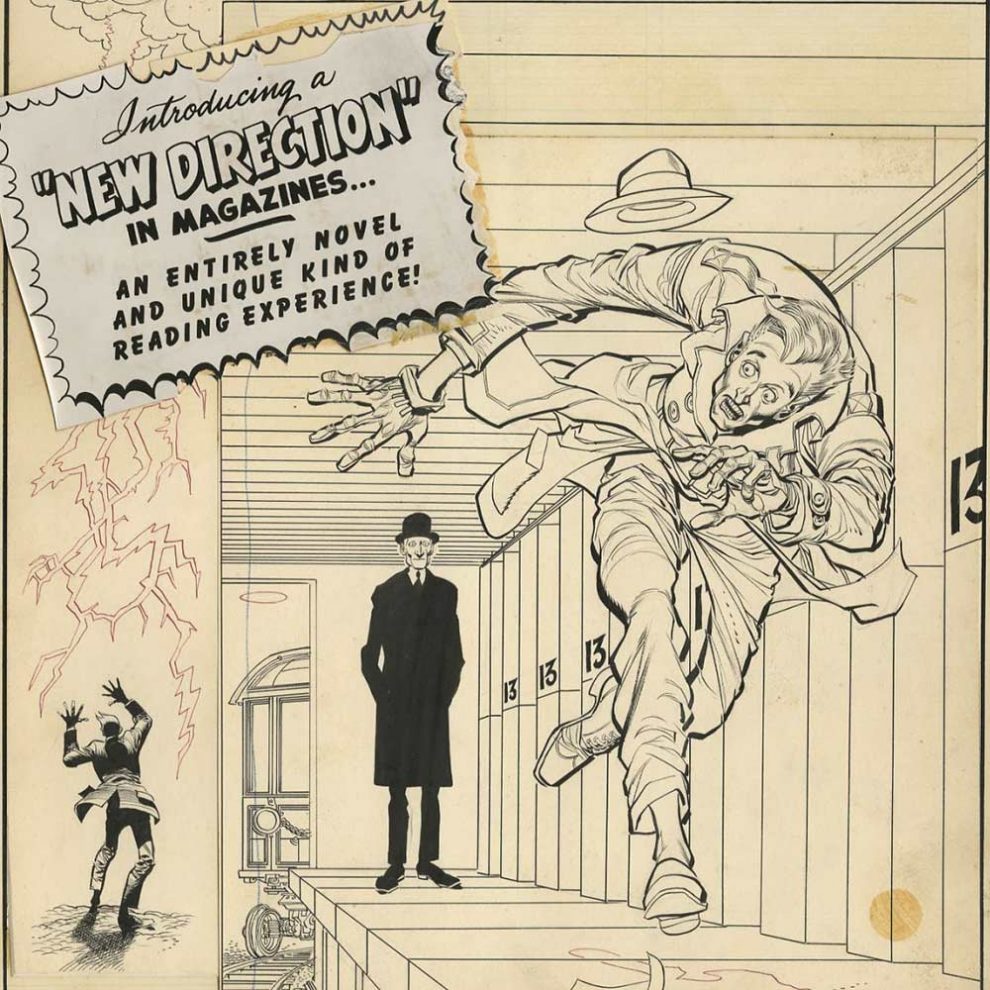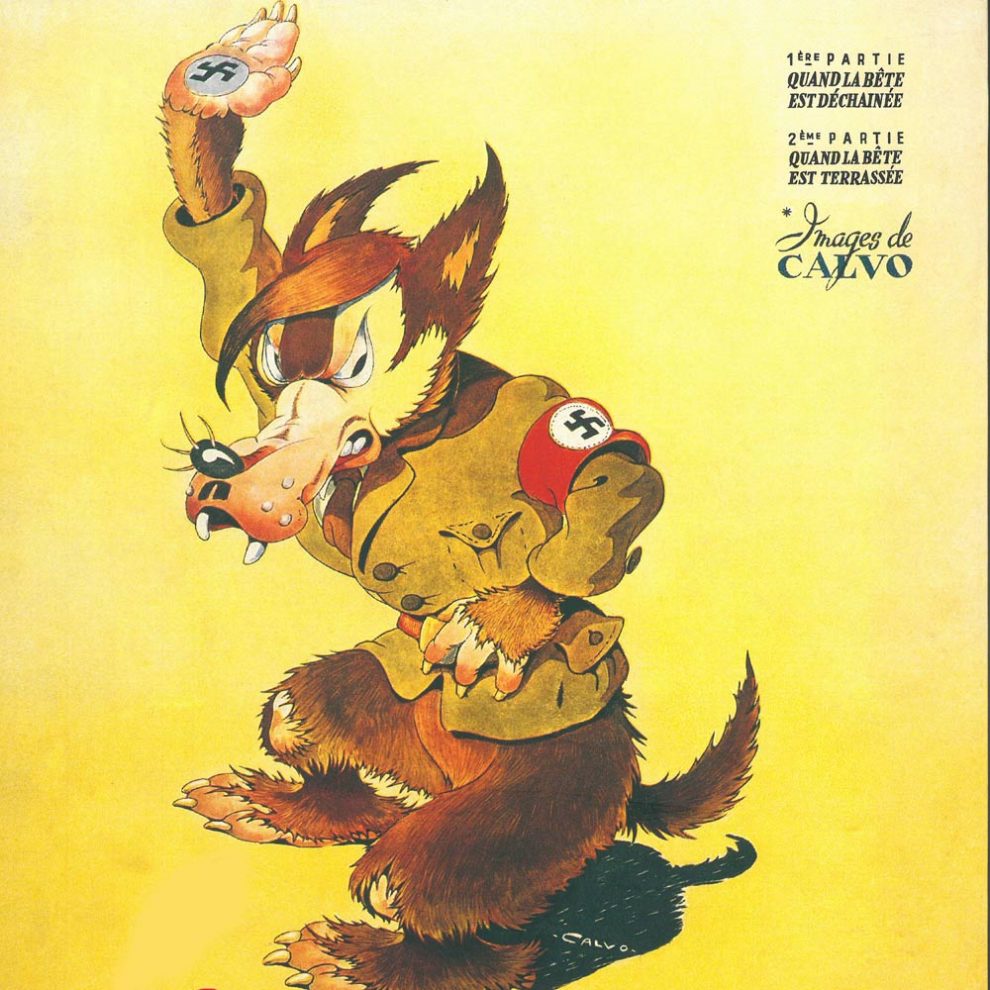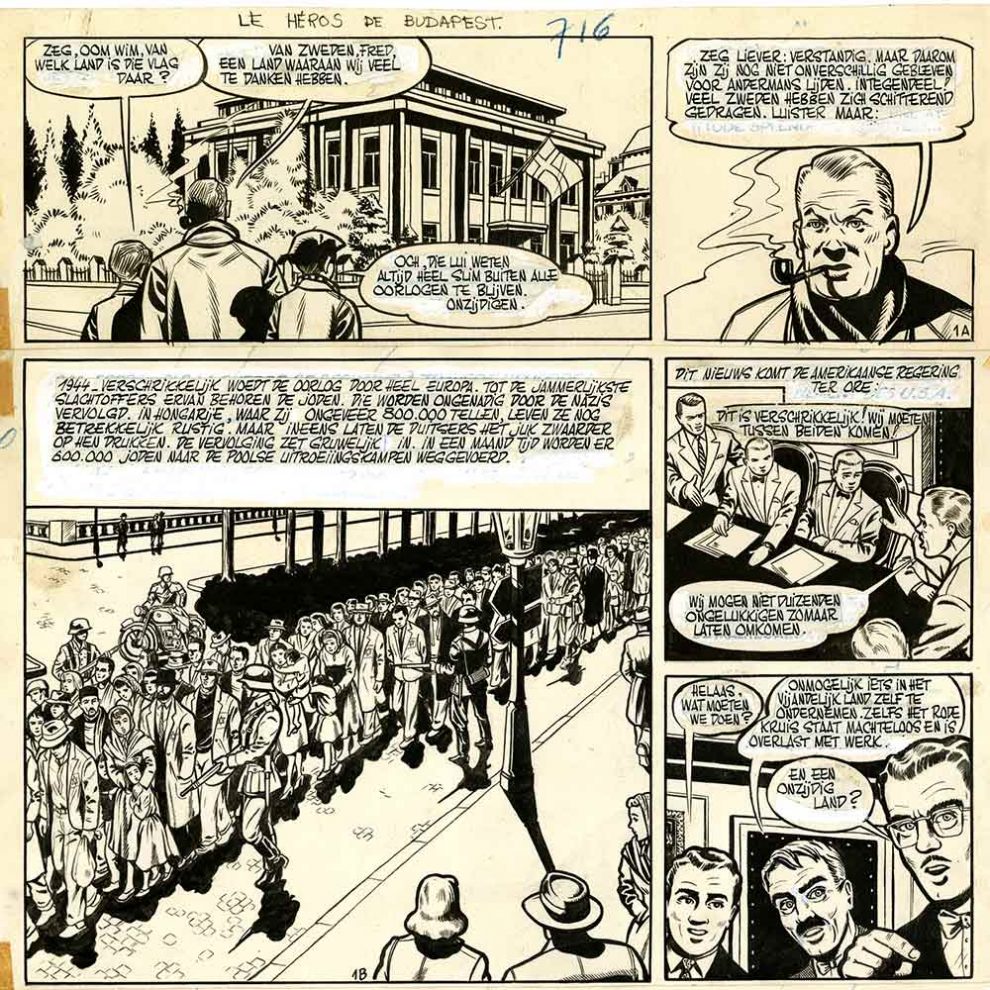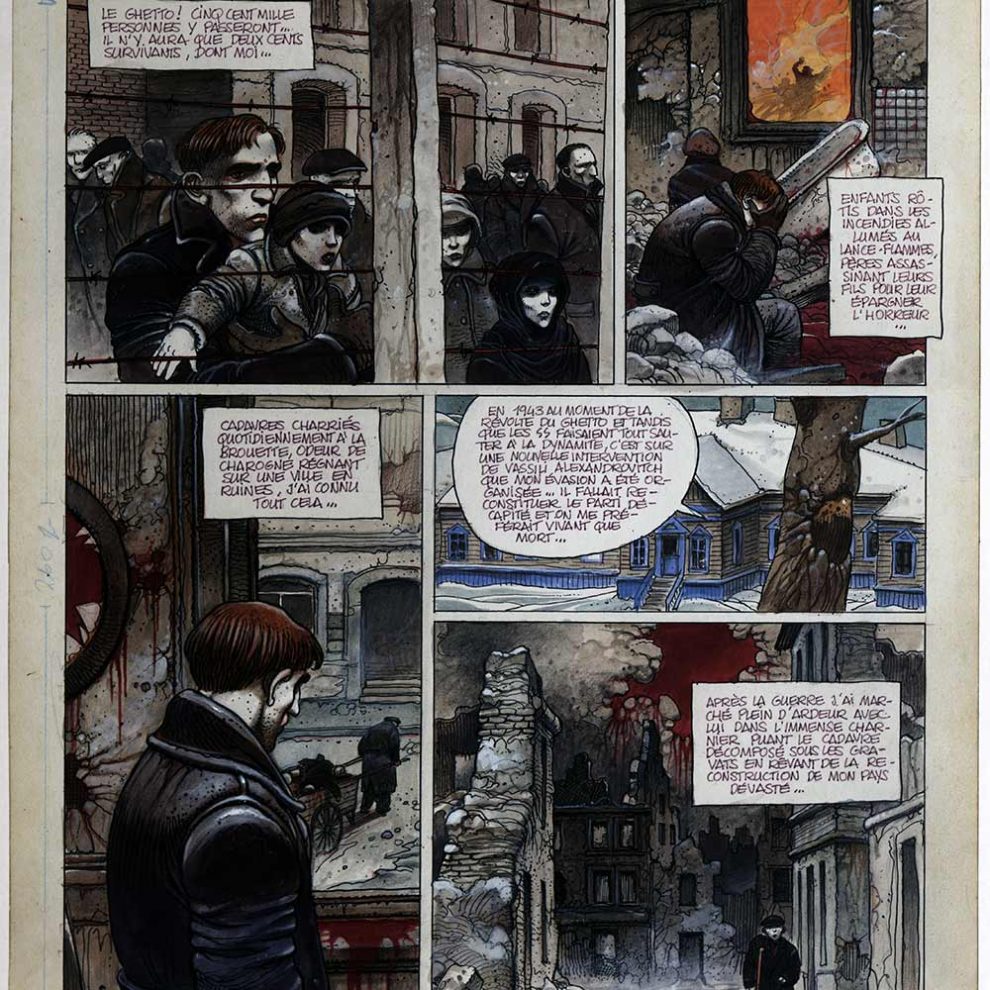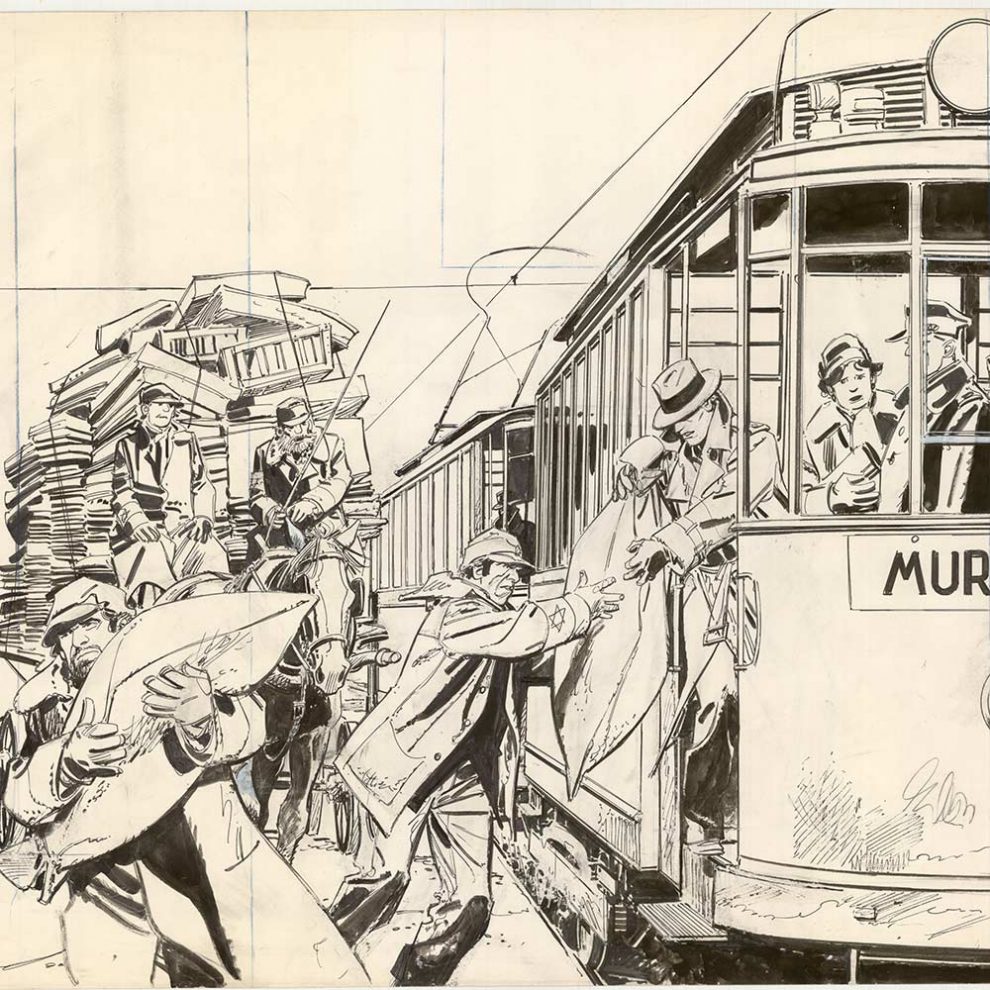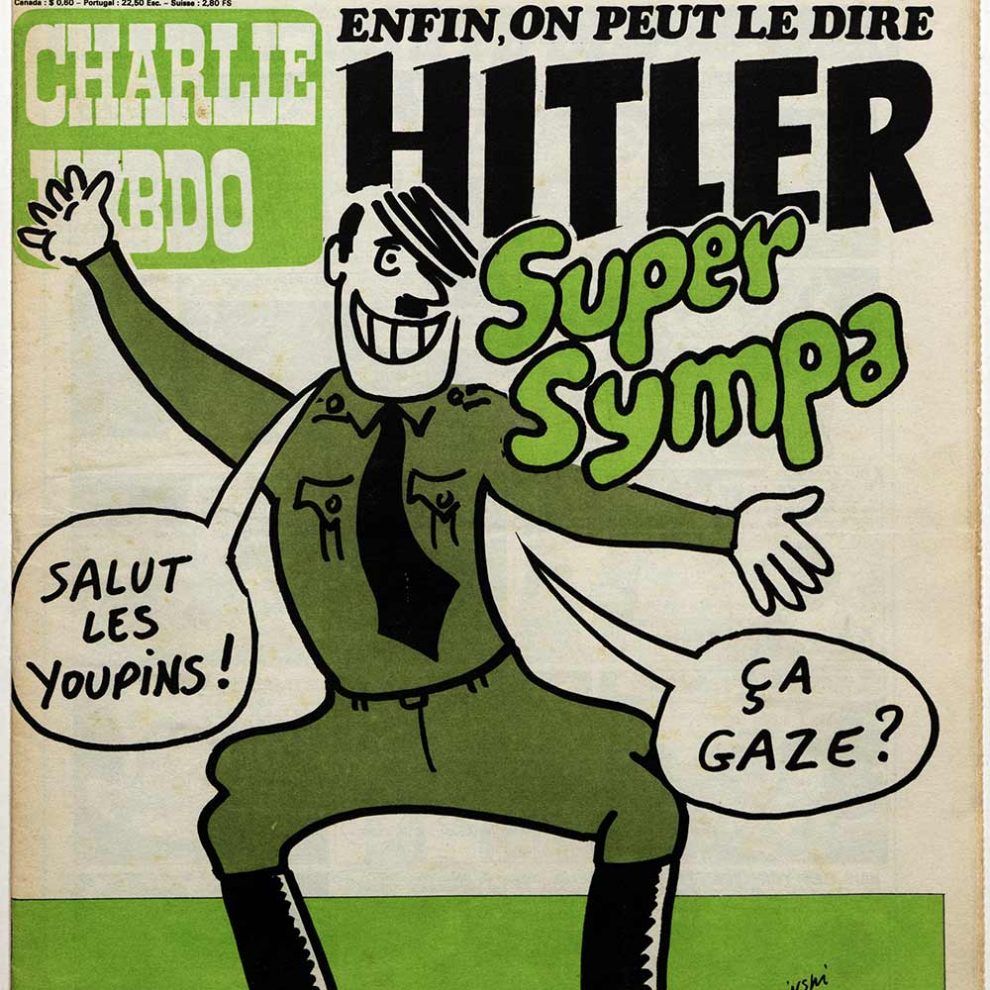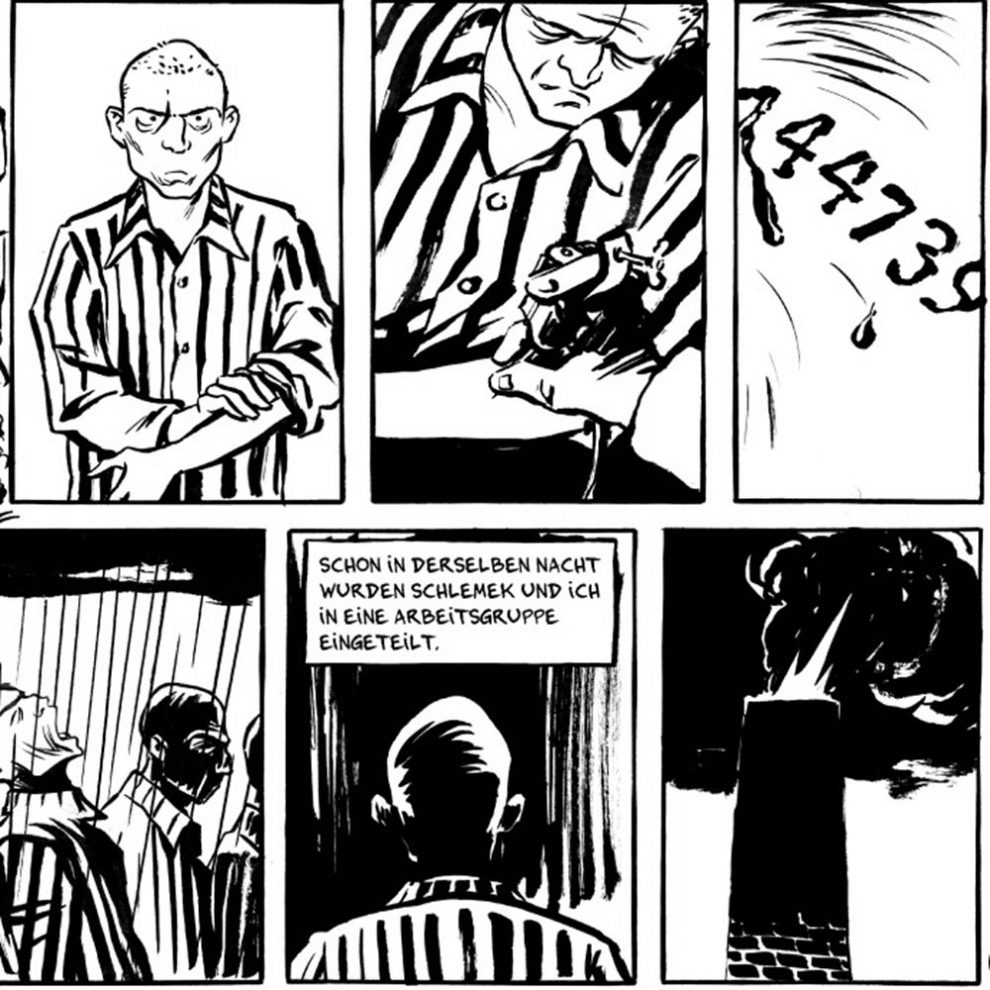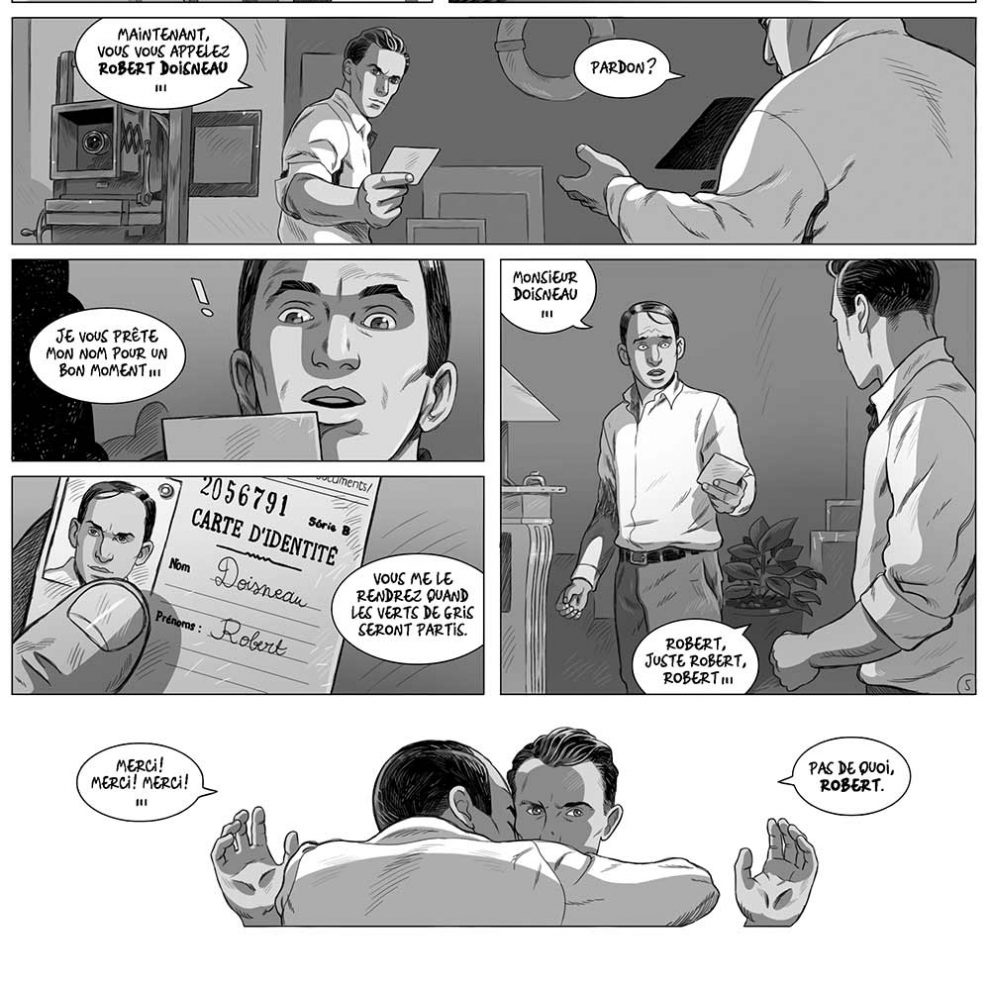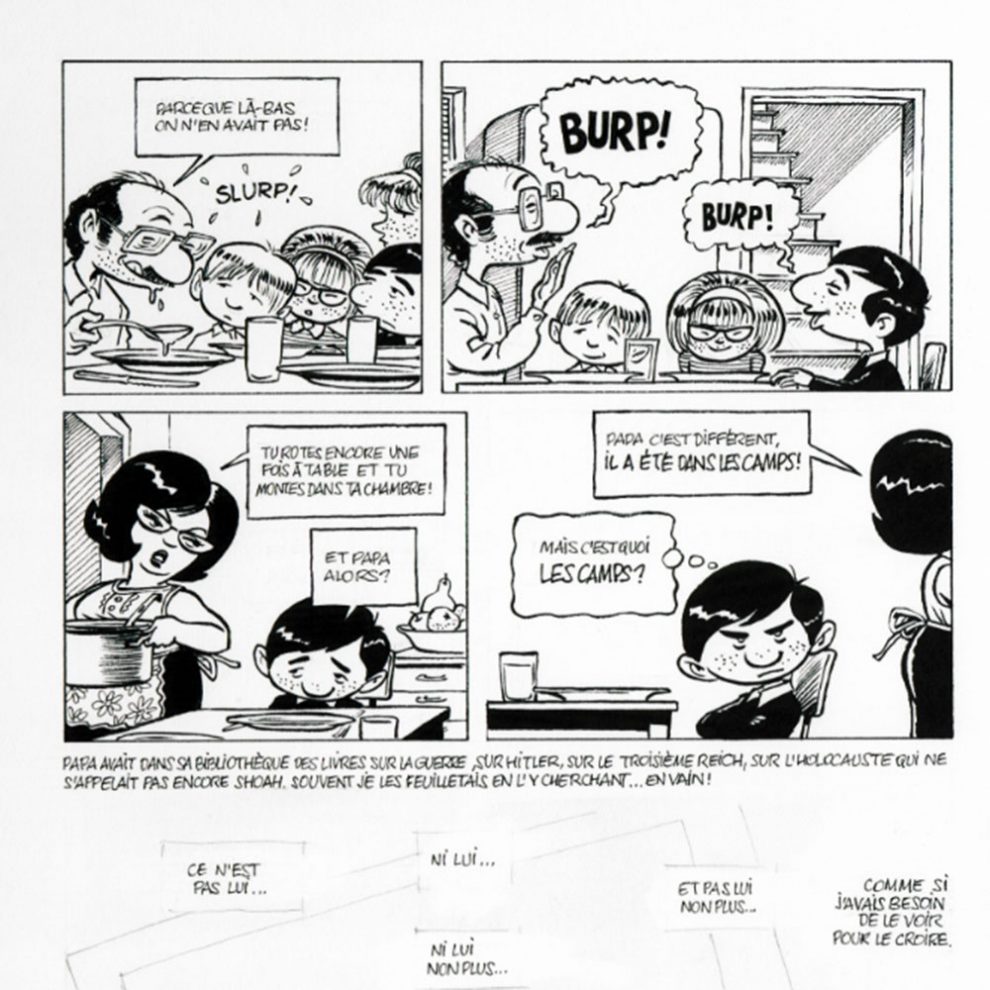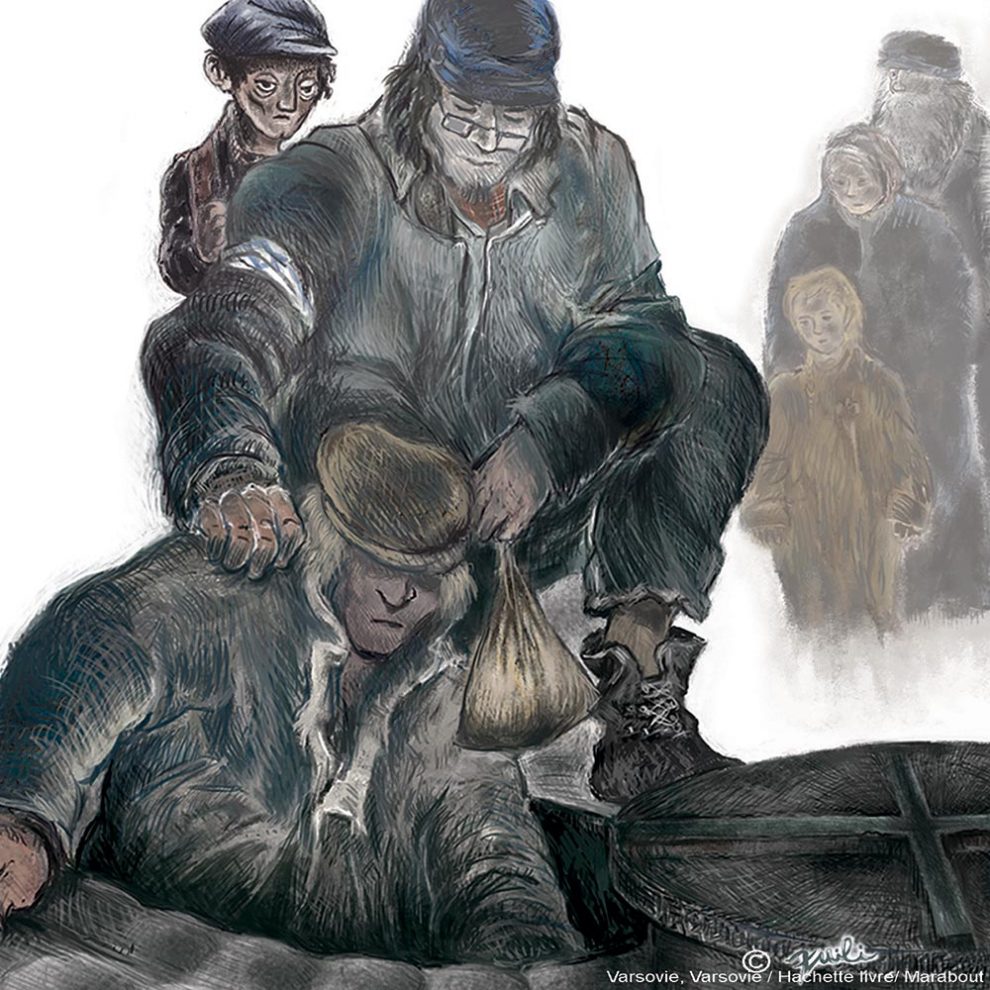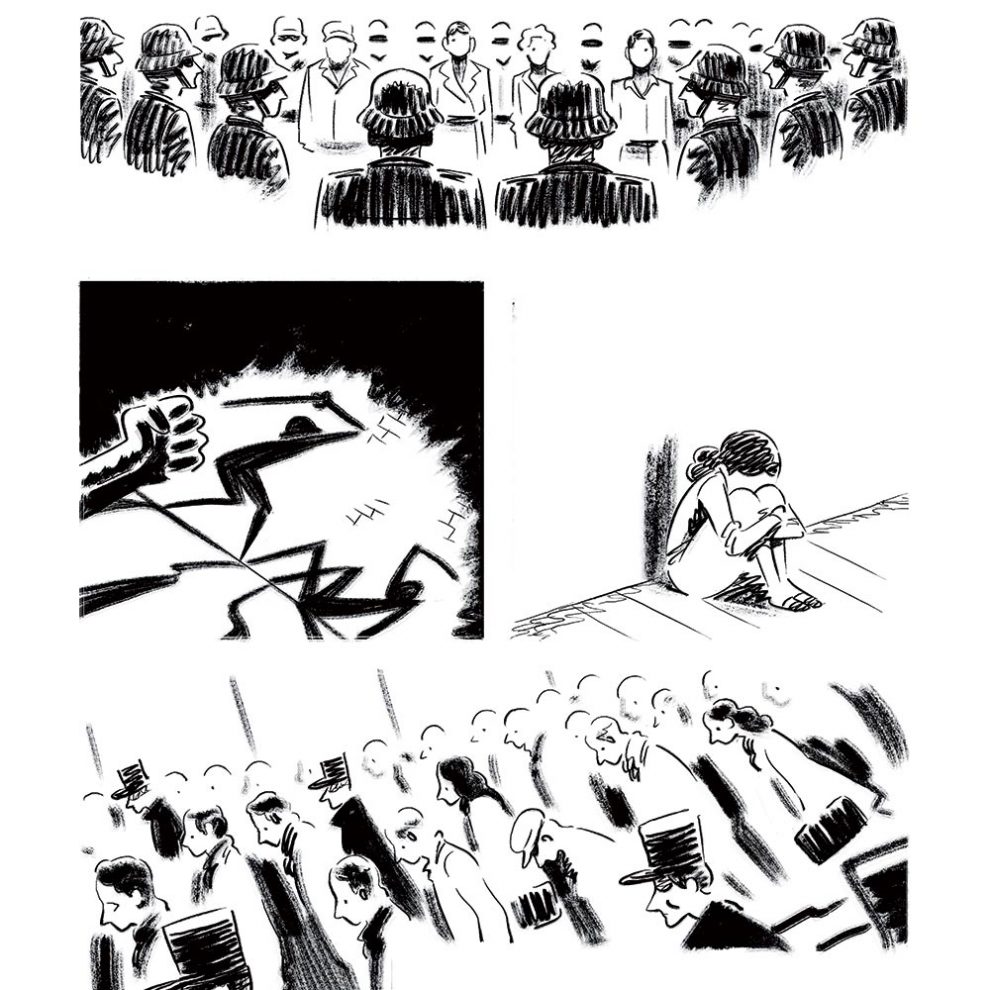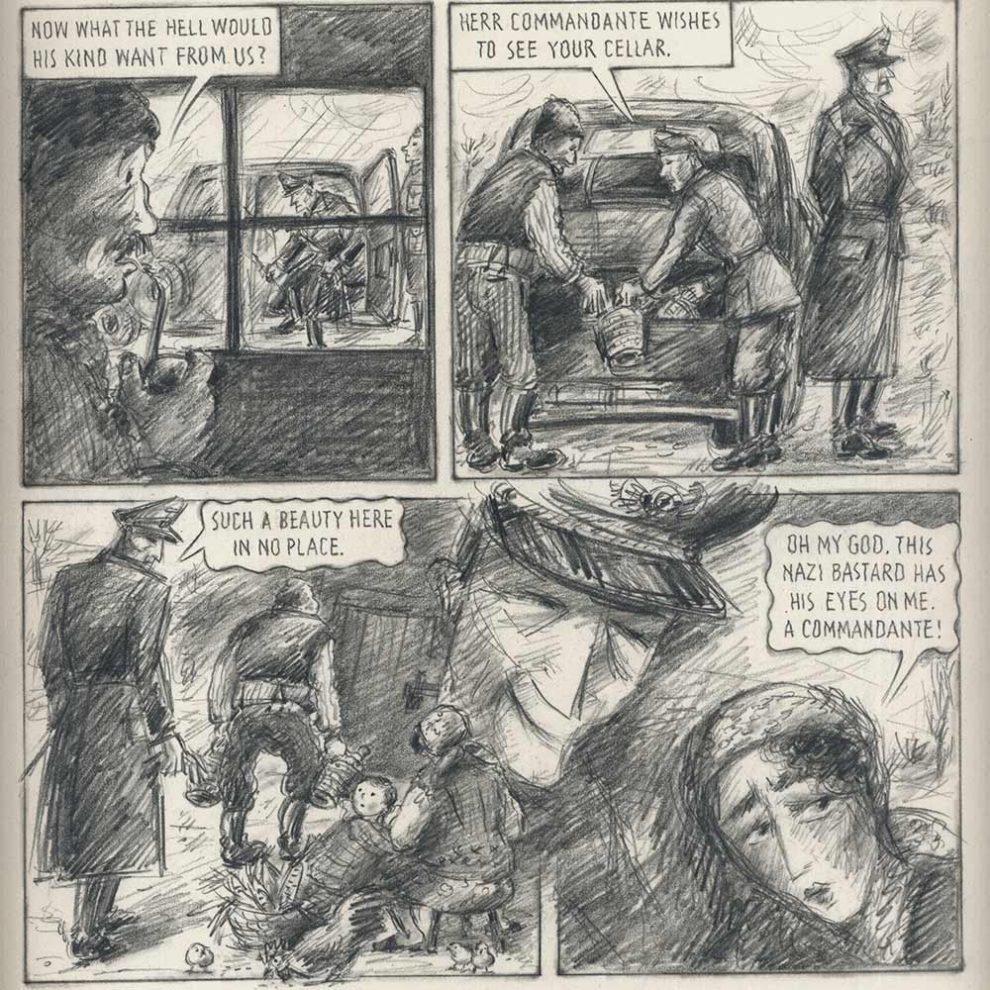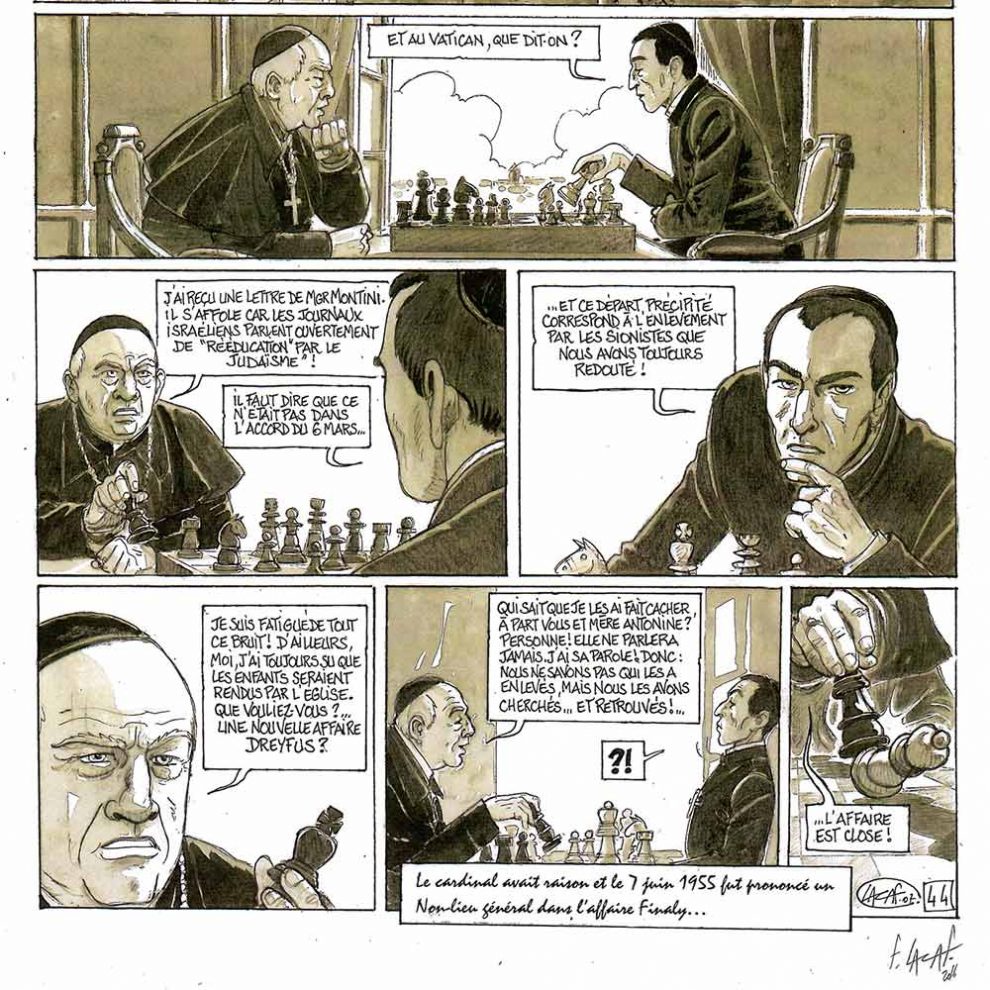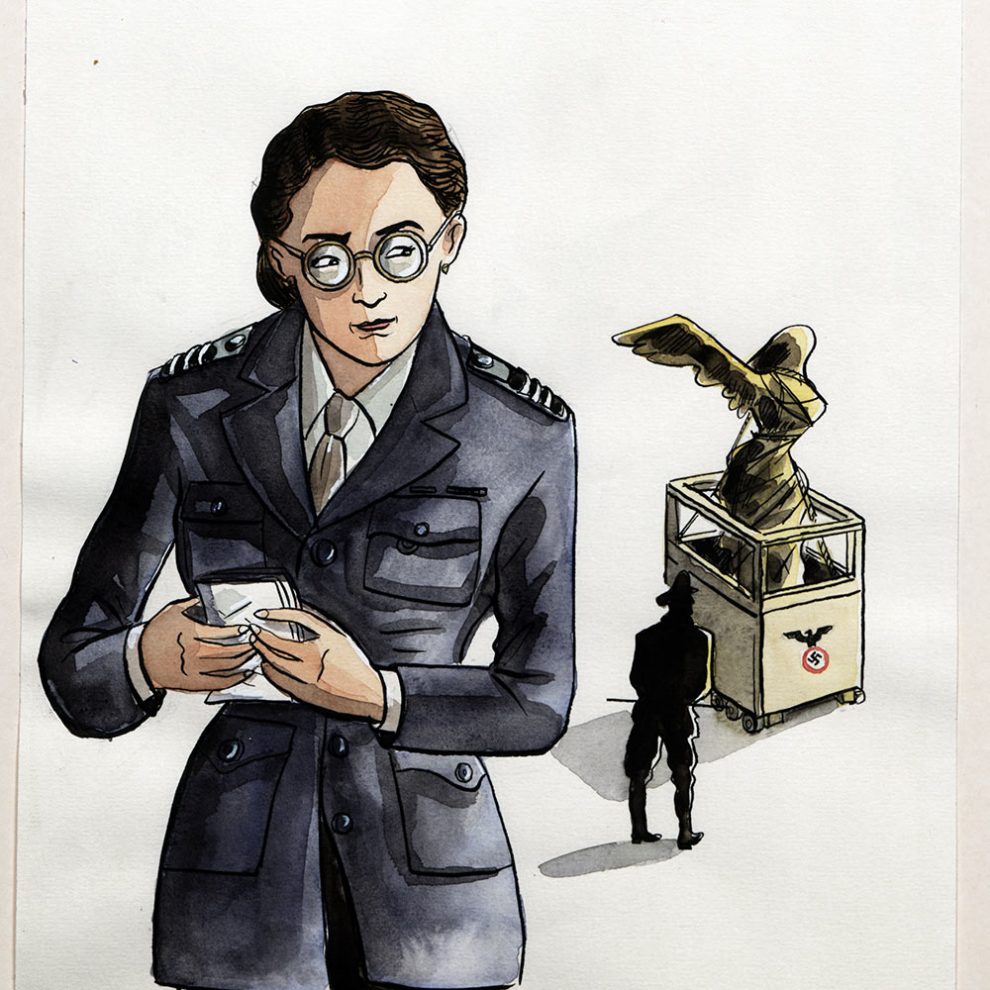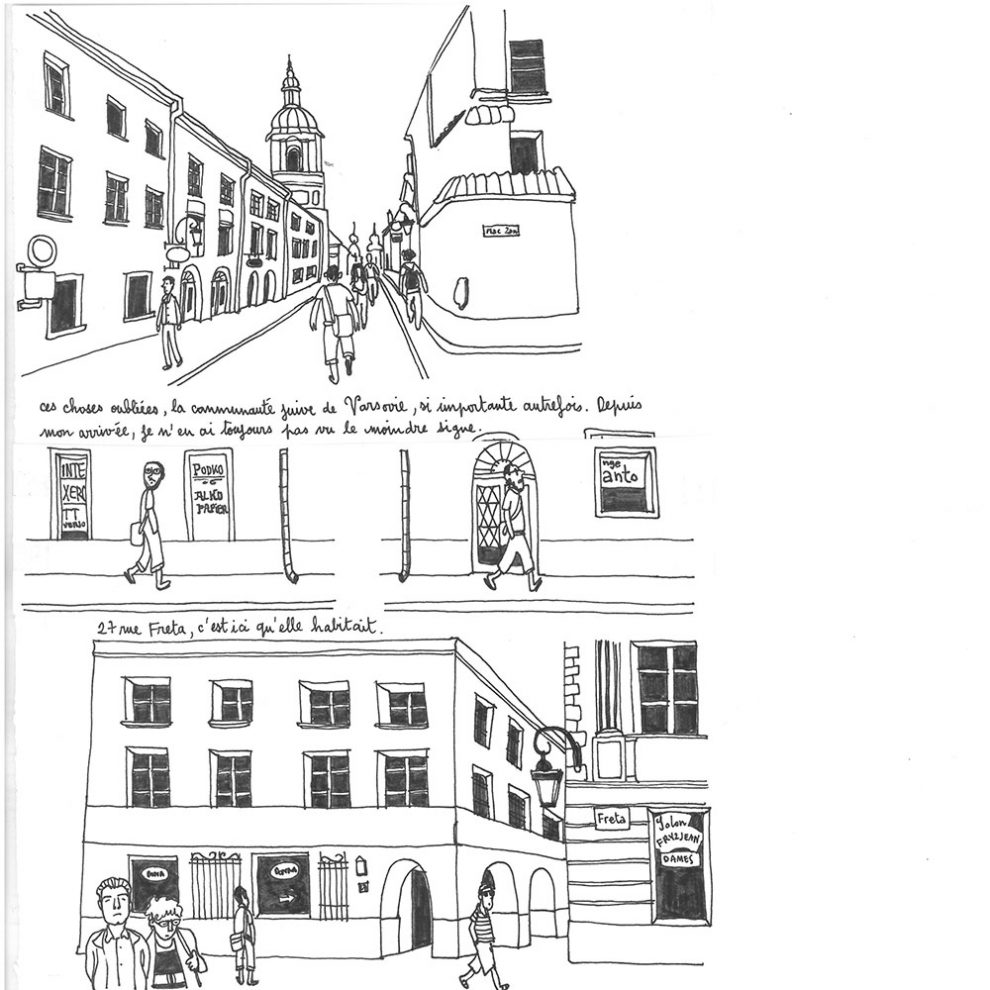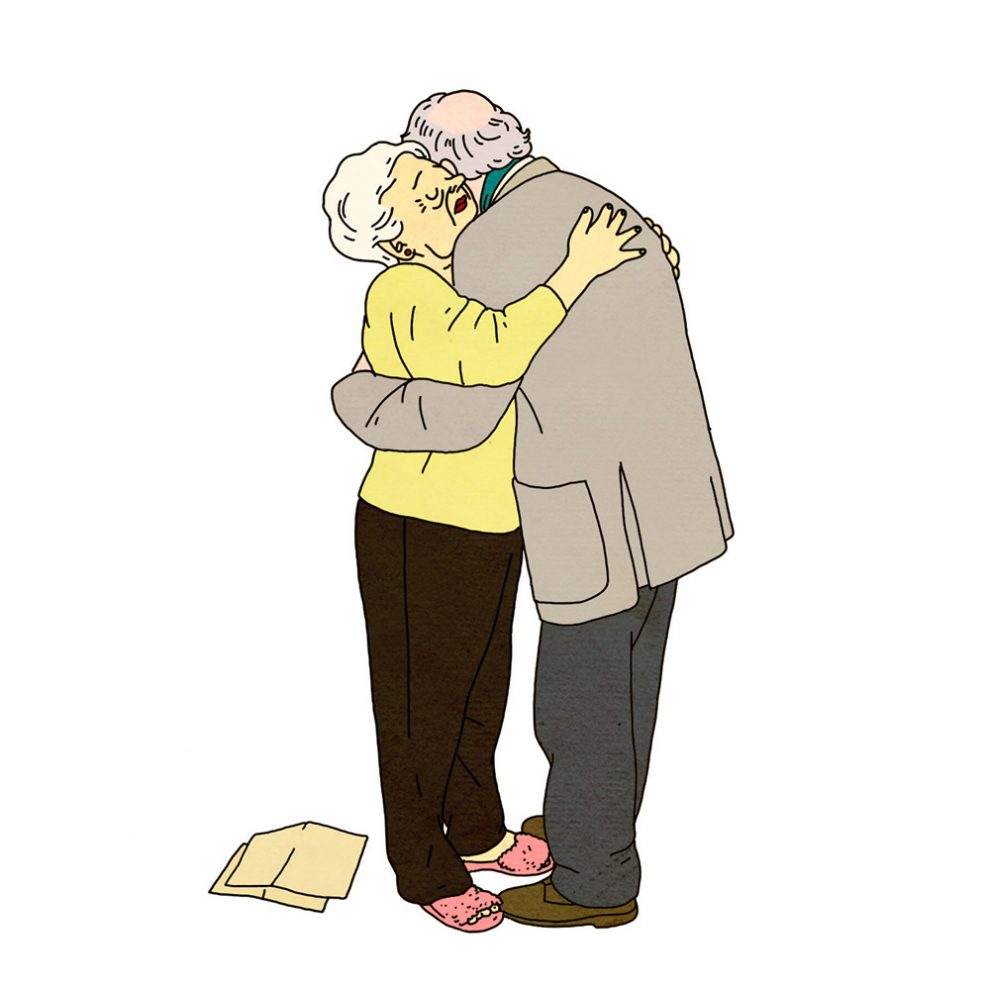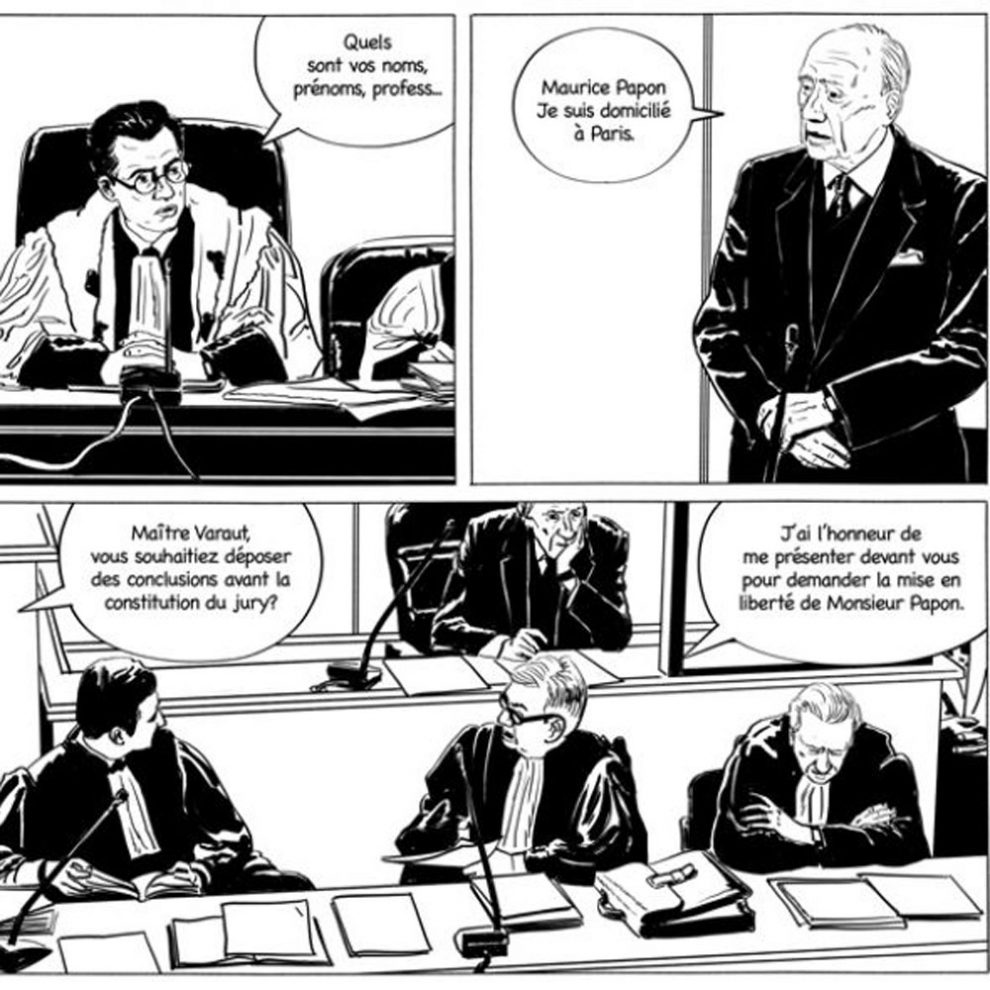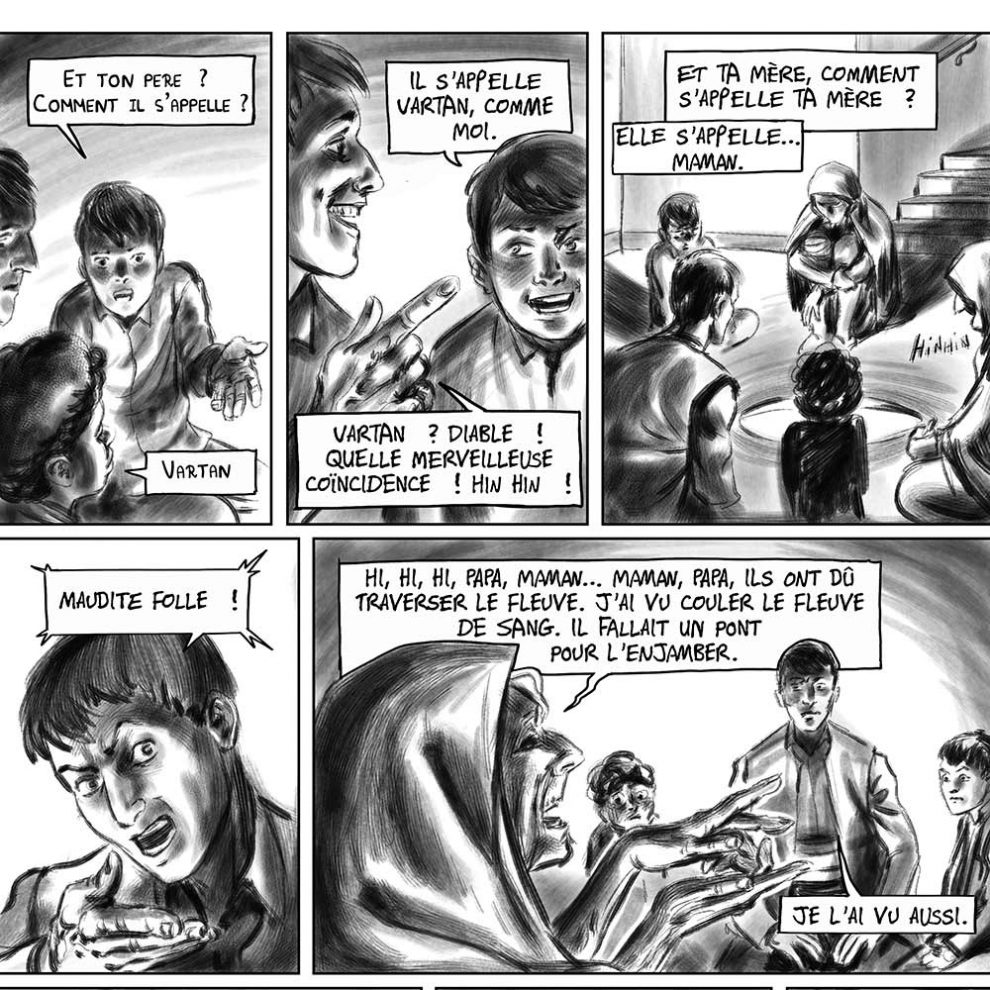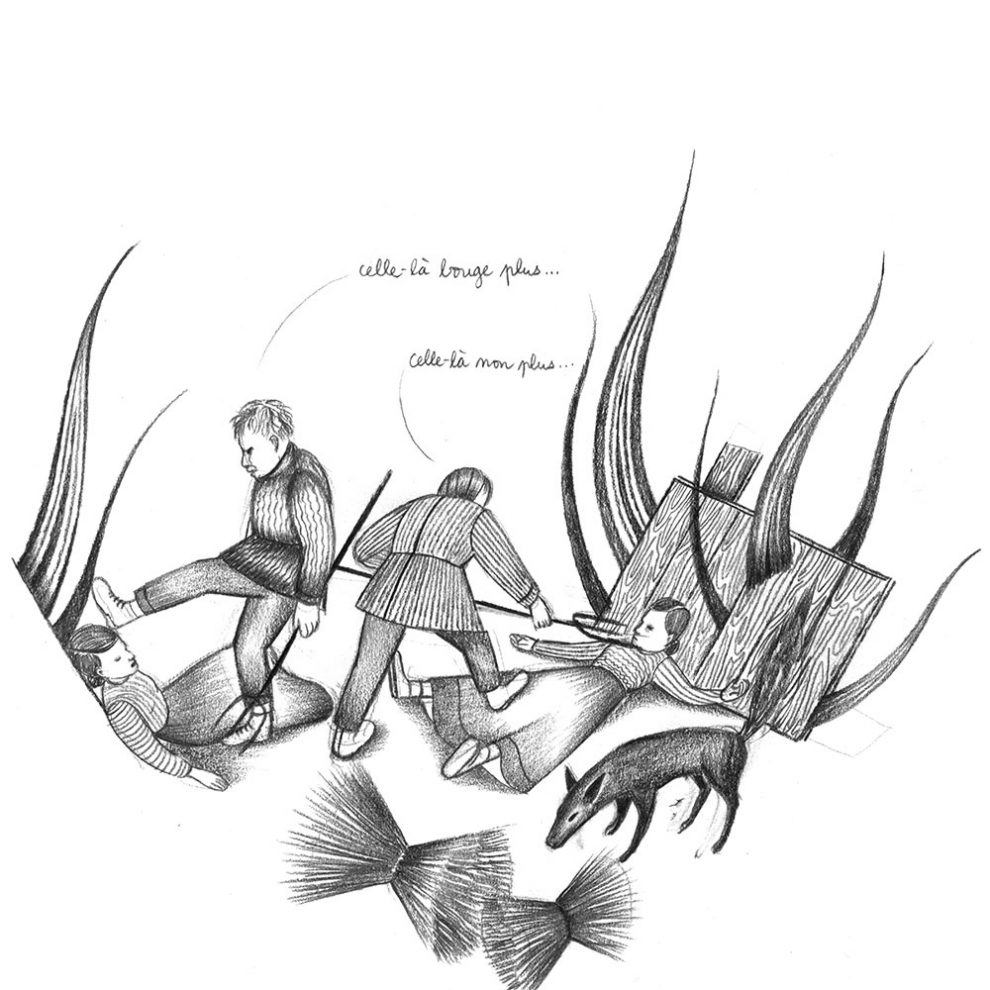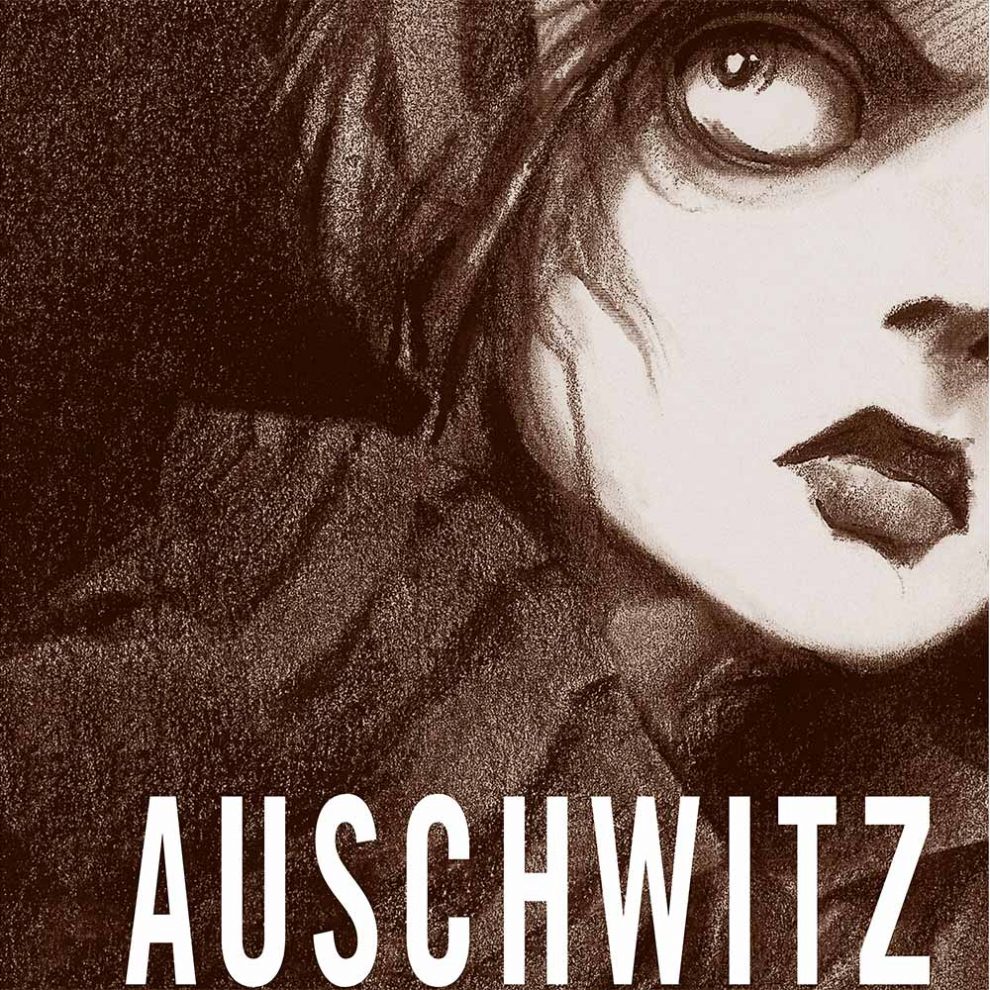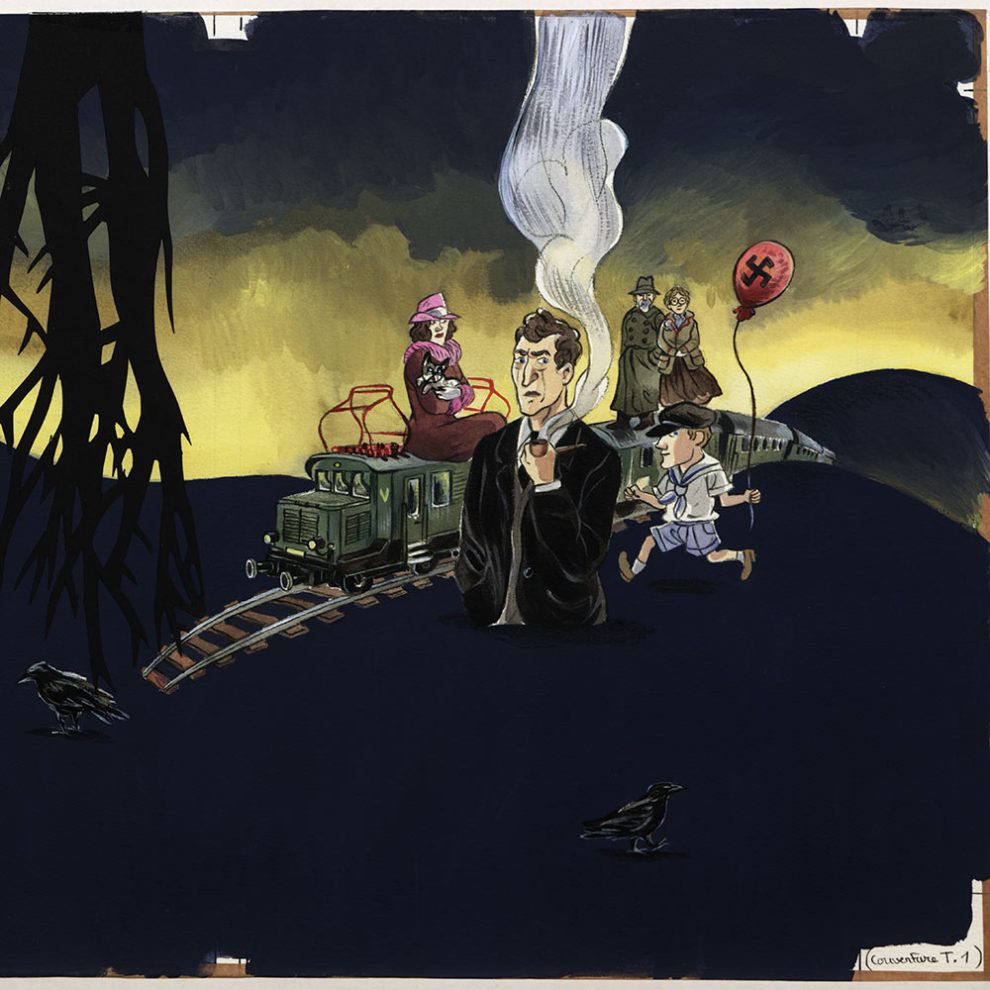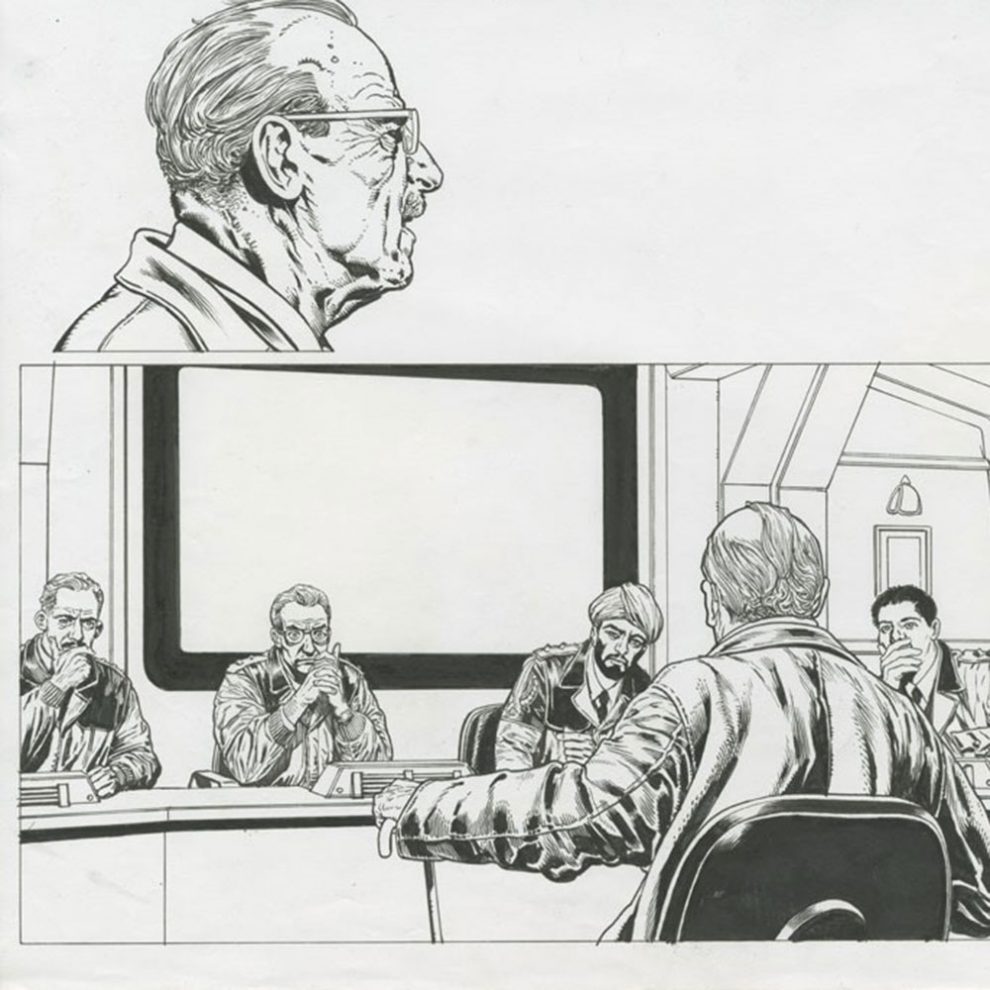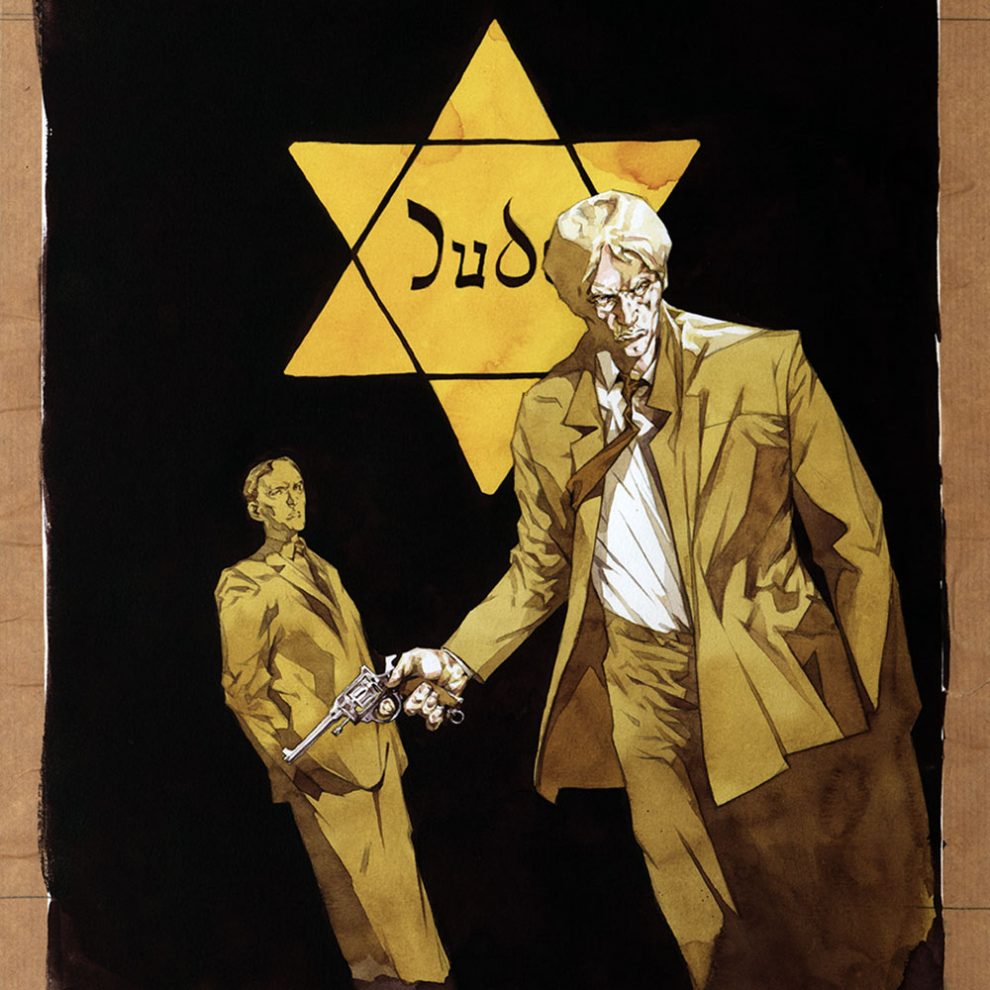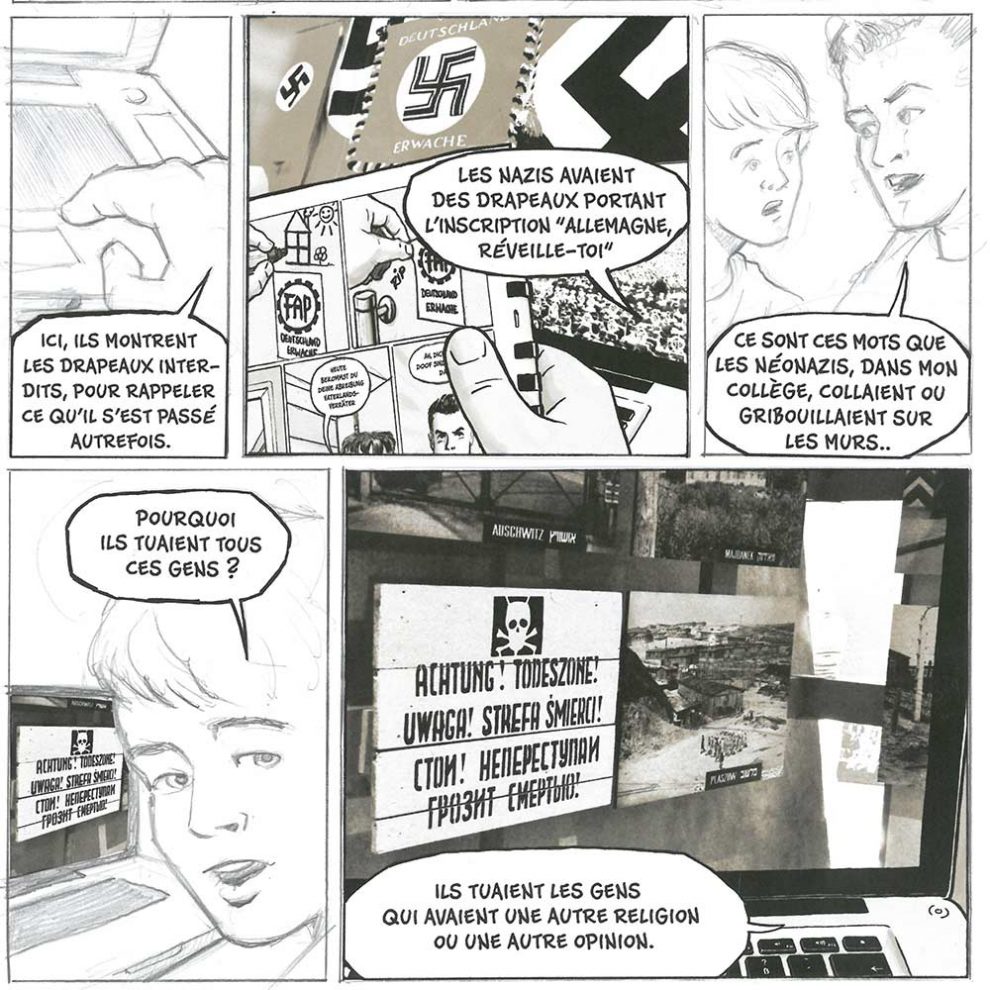
19 January to 30 October 2017
Not without caution, through trial-and-error, sometimes brilliantly, comics tackled a topic as universal as it is unspeakable: the destruction of European Jews. The Holocaust and Comics invites you on a historical and artistic journey through this art form, focusing on its visual sources, relevance, reach and limits.
Birth of a subject
First witnesses, earliest drawings
The exhibition’s first part sheds light on the pioneers: eyewitnesses and victims. The earliest narrative sketches do not exactly meet the definition of comics, but they are series that make sense. contemporary with the Holocaust, most of these testimonies were created in secrecy. Using brushes and pencils, artists described the horror and absurdity of their daily lives in the heart of hell. No camera or text could have so poignantly expressed the reality of the genocidal process unleashed against Europe’s Jews.
A seminal work
Mickey Mouse in the Gurs Camp, by Horst Rosenthal
In 1942, an unknown cartoonist named Horst Rosenthal drew 15 watercolors and compiled them in a hand-bound album called Mickey Mouse in the Gurs Camp. On the cover he wrote, “Published without permission from Walt Disney”. The narrator is Mickey Mouse: the author refracts his point of view through the lens of anthropomorphism, a technique later used by Calvo and Spiegelman. This is one of the first eyewitness accounts capturing the horror of French concentration camps.
Things to see in the exhibition
- Mickey Mouse in the Gurs Camp by Horst Rosenthal
- David Olère’s drawings, which unequivocally attest to the unthinkable reality of Auschwitz.
- The work of Chaïm “Jim” Kaliski directly testifies on the plight of Belgian Jews under the Occupation. His father was arrested and killed in Auschwitz in February 1944.
The elephant in the room
It was relatively late before comic-book artists first brought an awareness of the Holocaust to their work. However, in France, Dancette and Calvo’s La Bête est morte! specifically mentioned the genocide in 1944, but through the lens of anthropomorphism, with animals standing in for human characters. The same year, Robert Rigot’s Cœurs vaillants (Brave Hearts) mentioned Mauthausen, but without referring to Jews. In the United States, the Photo-Fighter cartoon in True Comics (1944) barely touched on the subject, even though Captain America had been mocking Hitler and his henchmen since 1941. In Europe, the persecution the Jews was absent from superhero stories. Just after the war, comics mentioned concentration camps, but Jews were not in them.
A seminal work
La Bête est morte !, by Edmond-François Calvo and Victor Dancette
In La Bête est Morte! (The Beast is Dead, 1944), which came out just a few months after the Second world war, Edmond-François Calvo and Victor Dancette turned people into animals. The germans are wolves, the french rabbits, the Belgians lion cubs, the English bulldogs, the Americans bison and the Russians bears. But the events recounted are specific enough to leave no doubt in young readers’ minds that these are the atrocities their parents had just gone through during the war.
Things to see in the exhibition
- Le Héros de Budapest (The Hero of Budapest) and Seul contre la barbarie (L’Oncle Paul) (Alone against Barbarism [Uncle Paul]) by Jean-Michel Charlierand Jean Graton are two four-page stories published in Spirou in 1952. The first mention of the Holocaust in Franco-Belgian comics, they are about the deportation of Hungarian Jews to Auschwitz.
- Al Feldstein and Bernard Krigstein’s Master Race, published in Impact #1, 1955, inventively and realistically described, for the first time, the murder of the Jews in an avant-garde form that still has shock power today.
A messy, difficult relationship
A slow start
The Holocaust was long off limits in comics and elsewhere. Superheroes gingerly stepped around extermination camps and sometimes went inside them, but never freed the prisoners. Perhaps that was for the best: while it was true that the United States was fighting Fascism, anti-Semitism still existed there. How could authors depict the genocide of the Jews? European and Japanese comic-book authors showed even less interest in the theme: they did not start featuring Jewish characters and the Holocaust until the late 1970s.
Why didn’t superheroes liberate Auschwitz?
Part two of the exhibition tries to answer that question by focusing on groundbreaking comic books.
Things to see in the exhibition
- X-Men vs. Magneto (Uncanny X-Men, #150, Oct. 1981) by Chris Claremont, Dave Cockrum, Josef Rubinstein, Bob Wiacek, Tom Orzechowski and Jean Simek
- What If Captain America Had Led an Army of Supersoldiers in World War 2? (the “What If?” series Vol. 2 #28, August 1991) by George Carragone, Ron Wilson and Ralf Cabrera
- For Those I Loved by Patrick Cothias and Paul Gillon (based on the book by Martin Gray, 1986)
- The Hunting Party by Pierre Christin and Enki Bilal
A seminal work
The Story of the 3 Adolfs by Osamu Tezuka
The Story of the 3 Adolfs has a unique point of view: it is the only known comic book about the Holocaust with a Japanese narrator. This singular work draws parallels with the history of Japan during the Second World War.
The Maus revolution
In 1980, Art Spiegelman, a figure in America’s underground movement, published Maus in a supplement of the avant-garde magazine RAW. This was the first time a comic book took the Holocaust as its main topic. Maus, which is also about the author’s difficult relationship with his father, an Auschwitz survivor, was published in two volumes in 1986 and 1991. The acclaim was unanimous. Spiegelman won a special Pulitzer Prize in 1992 as well as many international awards, including the 2011 Grand Prix d’Angoulême, and for good reason: Maus not only changed the perception of the Holocaust in comics, but also ushered in an aesthetic revolution that transformed how the world views them.
Gallows humor
Marvin J. Chomsky’s TV series Holocaust (1978) undeniably left a mark on its time and inspired a wide range of reactions, including satires. But is humor compatible with the compassion and respect owed to the victims? The debate is still on.
Things to see in the exhibition
- Drawings by Georges Wolinski, including one for the cover of an issue of Charlie Hebdo entitled Hitler super-sympa (Super-Nice Hitler). The cartoon seems shocking out of context. But in fact, this issue hit the newsstands on 2 November 1978, a few days after Darquier de Pellepoix claimed that only lice were gassed at Auschwitz in an interview in L’Express.
- Uri Fink and Gabriel Etinzon, who wrote Histoires d’une région enragée (Tales from an Angry Region, January 2006), parodied Art Spiegelman’s Maus in a story called Hummaus.
Transmission and reference
Memorials
Maus had a cultural and commercial impact on the image and status of comics. Bookstores started selling graphic novels, prompting the emergence of major memorial works such as David B.’s L’Ascension du haut mal (1996), Marjane Satrapi’s Persepolis (2000), Antonio Altarriba and Kim’s El Arte de Volar (2011) and Riad Sattouf’s The Arab of the Future (2015). The Holocaust joined the trend towards revealing identities, returning to sources and recalling traumas.
A seminal work
In 2012, Michel Kichka bravely tread in Spiegelman’s footsteps by publishing the testimony of a survivor’s child. This work’s maturity and restrained emotive power make it a veritable generational benchmark.
Things to see in the exhibition
- Yossel by Joe Kubert, an autobiographical story based on history where the young Yossel, an orphan in the Warsaw ghetto, survives by drawing for the Nazis.
- Vivre libre ou mourir: L’autre Doisneau (Live Free or Die: The Other Doisneau by Raphaël Drommelschlagerand Jean-Christophe Derrien is about how Robert Doisneau forged identity papers for Jews, even letting one use his own identity.
- Femmes en résistance: Mila Racine(Women in the Resistance: Mila Racine) by Emmanuelle Polack, Régis Hautière, Francis Laboutique and Olivier Frasier. Acting on a proposal by historian Emmanuelle Polack, between 2014 and 2016 Les éditions Casterman published biographies of four remarkable women in the Resistance.
- The Boxer by Reinhard Kleist tells the amazing story of Hertzko (Harry) Haft, a Polish Jew who survived Auschwitz by boxing for the Nazis.
- Varsovie, Varsovie (Warsaw, Warsaw) by Didier Zuili is about armed and civil resistance in the Warsaw gOnly visible in the exhibition, coming out in 2017!
The Holocaust and children
Some comic books have been specially designed to stimulate young readers’ minds, usually with stories about children, the Holocaust’s ultimate victims. At first, they featured testimonies by hidden children. After 2000, fictional stories were written about the rise of anti-Semitism, racial laws, exclusion, deportation and final Solution, usually with accuracy and a concern for educating children.
A seminal work
Seules contre tous by Miriam Katin
When the Nazis invaded Hungary in 1944, three-year-old Miriam Katin and her mother, Esther, hid in the countryside. The author reconstructed her memories based on her mother’s testimony. In 2006, at the age of 63, she wrote her first graphic novel, the 120-page We Are on Our Own: A Memoir. It was her first book about the Holocaust from a woman’s viewpoint.
Things to see in the exhibition
- The Diary of Anne Frank has been the best tool for teaching teenagers about the Holocaust. However, the story was not adapted into a comic book until 2016, after falling into the public domain. Nadji’s elegant drawings never lapse into misplaced aestheticism and keep all the spontaneity of Antoine Ozanam’s
- Les Enfants cachés by Catherine Poujol and Fabien Lacaf tells the true story of the two- and three-year-old Finaly siblings, who were entrusted to a Catholic institution in Grenoble by their mother and father shortly before their deportation to Auschwitz. It took eight years of legal battles before the children finally returned to their family.
The judgment of history and spoliation
With the rising number of testimonies since the 1980s, some comic-book authors have tried to find new perspectives and angles. The writing and drawing are inventive. Creators approach the memory of the Holocaust through the lens of their sensibilities, bringing it to life again and again.
Comic-book authors have also tackled a lesser-known theme, the spoliation of the Jews, a step on the way to the final Solution.
Things to see in the exhibition
- Nous n’irons pas voir Auschwitz, by Jérémie Dres. “There are no more Jews in Poland,” Jérémie Dres’ recently deceased grandmother had told him. He and his brother decided to find out if she was right. His astonishing graphic novel is about their search for Poland’s last Jews as they carefully avoid Auschwitz.
- A Life Force by Will Eisner: Bronx resident Jacob Shtarkah leads a busy life supporting his family, indifferent to Jewish traditions. His world turns upside-down when a letter pleading for help arrives from his childhood sweetheart in Germany.
- Rose Valland, capitaine Beaux-Arts(Rose Valland, Captain Fine Arts) by Claire Bouilhac, Catel and Emmanuelle Polack: art history expert Rose Valland was a self-effacing but headstrong heroine who stubbornly thwarted the Nazis’ spoliation of Jewish property.
- the Property by Rutu Modan: In this book, Israeli author Rutu Modan, who won many awards for Exit Wounds, tackles the Holocaust for the first time. It is about an old woman, Regina Segal, who, with her granddaughter Mica, returns to Poland to try to reclaim family property that the Nazis had stolen during the
Transmission and reference
The Holocaust has become the gold standard for work on memory, especially for the Armenian and Tutsi genocides, but also other victims of Nazism, including disabled people, gypsies and homosexuals. Here again, artists tackle these topics with their own sensibilities, transmitting things that neither documentaries nor essays can. Comics are a devilishly effective means of mediation and the transmission of memory.
A seminal work
This work is about the rescue of two Armenian children. “The general idea for the story came to me after a talk with a Turkish nationalist member of parliament,” says writer Gorune Aprikian. “He told me that in 1915 his grandfather came from a family Adjar (a region now in southern Georgia) but his grandmother had no origin. Reading between the lines, I realized that he was confiding in me that this grandmother was Armenian. I couldn’t sleep that night thinking that for the Armenians, this woman died in 1915 and for the Turks, she was born at the age of 16 in 1915. Nobody told her whole story.”
Things to see in the exhibition
- Déogratias by Jean-Philippe Stassen.The Tutsi genocide is recalled through various characters, Hutu extremists, Hutu moderates, Tutsi victims and European witnesses. The story takes place in several sequences before, during and after the genocide.
- Manouches by Kkrist Mirror. For years, Mirror has perpetuated the memory of the Manouches, who were also victims of the Nazis. With his dark, thick, expressionistic line, he perfectly renders the life, condition and even the language of these deeply touching characters.
One subject among others
The metaphorical vein
Once authors felt free to depict the Holocaust, they seized upon it as the ultimate symbol of absolute evil. Nothing seemed to equal its evocative power. Hellboy and Magneto are children of the Holocaust, conceived by what is considered the height of madness. Genocidal anxiety underlies Alan Moore and David Lloyd’s masterpiece V for Vendetta, but with a new, more open perspective. In the same metaphorical vein as Maus, new stories feature humans in other guises: ghosts, monsters, repugnant animals, even vegetables.
Things to see in the exhibition
- Auschwitzby Pascal Croci. Interesting as it is, this album poses a problem. The plot is about an SS officer who allows a child who survived gassing to live. But this scenario is completely implausible: no child under 12 survived Auschwitz. Croci defends his narrative choices, claiming the right to poetic license.
- Le Lait noir (Black Milk) by Fanny Michaëlis.This story is about Peter, a Jewish Berliner in the heart of Nazi darkness. As the threat closes in, Peter, who is none other than the author’s grandfather, decides to leave his homeland forever. “Who knows what becomes of those we see leaving the cities and countryside in rows, flanked by soldiers,” the mother tells the boy.
Fiction and co
Fiction not only magnifies reality but also surpasses the bounds of the imaginable, if not the reasonable. In I am Legion, Fabien Nury and John Cassaday (2004) give the Second world war an other-worldly dimension by turning Jewish victims into golems thanks to vampire blood. They are certainly not Holocaust deniers, but what effect do these kinds of stories have on their readers’ minds? What traces do they leave in memories, especially of young readers?
Things to see in the exhibition
- Sir Arthur Benton by Tarek and Stéphane Perger(2005) is about a Nazi mole who infiltrates the British secret services to document the fact that the Allies were perfectly aware of the details of the Wannsee conference, the purpose of which was to ensure cooperation from the heads of various government departments in implementing the Final Solution.
- X-Men: Magneto, the Testament by Greg Pak and Carmine di Giandomenico. After the success of the first scene in X-Men, which puts Magneto in Auschwitz, in 2009 writer Greg Pak developed the anti-hero’s past in a five-part mini-series.
- The Ministry of Space by Warren Ellis and Chris Westonis a uchrony where the English reach the moon before the Americans and Russians because they found “the Jews’ gold” stolen by the Nazis.
-
Joanna Schippers’ thriller Le printemps refleurira (Spring Will Bloom Again) takes place in a stifling setting aboard a train. The plot: in 1937, a Jewish painter living in France sets out to look for his son in Poland but is caught by the SS.
Conclusion
An endless war
It seems only fitting to end the exhibition, which spans over 70 years, all genres and every style, with a tribute to Will Eisner, who, better than anyone, embodies the adventure of comics with his unclassifiable talent. The Eisner Awards, the highest honor comic-book authors can receive in the United States, are named after him. In the autumn of his life, Eisner realized that he had to tackle anti-Semitism, an eternal scourge. Some of his work is on display in the exhibition.
The Holocaust entered the world of comics just as they finally achieved cultural recognition and graphic novels became a popular way to remember the past. Stereotypes and preconceived ideas abound in these works, which are of incomparable aesthetic quality. They invite us not only to sharpen our critical thinking skills, but also to increase our vigilance.
A seminal work
The Plot: The Secret History of the Protocols of the Elders of Zion by Will Eisner
Illustrated by a master’s hand, this thrilling story was published in the United States and France shortly after Eisner’s death in 2005. It dissects the fabrication of The Protocols of the Elders of Zion, the famous forgery by Russia’s secret police aiming to convince Czar Nicholas II that the Jews were trying to take over the world.
Things to see in the exhibition
-
Set in the 1980s, Nils Oskamp’s Drei Steine (Three Stones, 2016) describes small, violent, far-right anti-Semitic groups in the author’s native region (Dortmund-Dorstfeld) and his resistance to the attempts by many of his classmates to recruit him. It ends with an emotional visit to Yad Vashem in Jerusalem.
